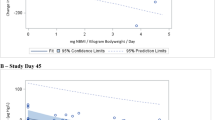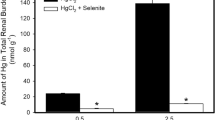Abstract
The effects of long-term daily intake of mercury on its urinary and fecal excretion, whole-body retention, and blood concentration in male rats were observed. The animals were exposed to mercuric chloride labeled with 203Hg via drinking water for 8 weeks (5, 50 and 500 μ m Hg). 203Hg in urine, feces and blood was quantified. The blood mercury concentration did not keep a linear relationship with the increasing dose. The percentage of the total amount of mercury intake which is excreted by the fecal route in rats exposed to 500 μ m Hg was significantly lower than in those exposed to 5 and 50 μ m. The daily dose percentage of mercury excreted in urine increased with dose size. The results show that the absorption fraction of mercury through the gastrointestinal tract (30–40%) was higher than values previously reported.
Similar content being viewed by others
References
Andrews PM, Chung EM. 1992 High dietary protein regimens provide significant protection from mercury nephrotoxicity in rats. Toxicol Appl Pharmacol 105, 288–304.
Berlin M. 1986 Mercury. In: Freiberg L, Nordberg GF, Vouk VB, eds. Handbook on the Toxicology of Metals. Vol. II. Amsterdam: Elsevier.
Berlin M, Gibson S. 1963 Renal uptake, excretion and retention of Hg(II) study in the rabbit during infusion of HgCl2. Arch Environ Health 6, 617–625.
Cember H. 1962 The influence of the size of the dose on the distribution and elimination of inorganic mercury, Hg(NO3)2, in the rat. Ind Hyg J 23, 304–313.
Daston GP, Kulock RJ, Rogers EM, Carver B. 1983 Toxicity of mercuric chloride to the developing rat kidney. I. Postnatal ontogeny of renal sensitivity. Toxicol Appl Pharmacol 71, 24–41.
Elinder GG, Gerhardsson L, Oberdoerster G. 1988 Biological monitoring of metals. In: Clarkson TW, Friberg L, Nordberg GF, Sager P, eds. Biological Monitoring of Metals. New York: Plenum Press.
Gibaldi M, Perrier D. 1975 Unavailability. In: Swarbrick J, ed. Pharmacokinetics. New York: Marcel Dekker.
Jakubowski M, Piotrowski J, Trojanowska B. 1970 Binding of mercury in the rat: studies using 203HgCl2 and gel filtration. Toxicol Appl Pharmacol 16, 743–753.
Mitane Y, Tohyama C. 1988 Urinary excretion of metallothionein in cadmiumand mercury-treated rats. Environ Occup Chem Hazards 8, 163–169.
Morcillo MA. 1992 Metallothionein as a biological indicator in rats exposed to inorganic mercury. Thesis. UAM, Madrid, Spain.
Morcillo MA, Santamaria J. 1993 Separation and characterization of rat kidney isometallothioneins induced by exposure to inorganic mercury. J Chromatogr 665, 77–83.
Morcillo MA, Santamaria J, Sanchez F, Ribas B, Bando I. 1992 Rat kidney metallothionein induced by subchronic exposure to inorganic mercury. In: Merian E, Haerdi W, eds. Metal Compounds in Environment and Life, 4. Northwood: Science and Technology Letters.
Nielsen JB. 1992 Toxicokinetics of mercury chloride and methylmercuric chloride in mice. J Toxicol Environ Health 37, 85–122.
Nielsen JB, Andersen O. 1989 Oral mercuric chloride exposure in mice: effects of dose on intestinal absorption and relative organ distribution. Toxicology 59, 1–10.
Nielsen JB, Andersen O. 1990 Disposition and retention of mercuric chloride in mice after oral and parenteral administration. J Toxicol Environ Health 30, 167–180.
Nolan CV, Snhaikh ZA. 1987 Induction of metallothionein in rat tissues following subchronic exposure to mercury shown by radioimmunoassay. Biol Trace Element Res 12, 419–428.
Nordlind K. 1990 Biologicel effects of mercuric chloride, nickel sulphate and nickel chloride. In: Ellis GP, West GB, eds. Progress in Medicinal Chemistry, Vol. 27. Amsterdam: Elsevier.
Piscator M. 1962 Proteinuria in chronic cadmium poisoning. Arch Environ Health 5, 325–332.
Rahola T, Hattula T, Korolainen A, Miettinen JK. 1973 Elimination of free and protein-bound ionic mercury (203Hg2+) in man. Ann Clin Res 5, 214–219.
Rothstein A, Hayes A. 1960 The metabolism of mercury in the rat studied by isotope methods. J Pharmacol Exp Therap 130, 166–176.
Rothsein A, Hayes A. 1964 The turnover of mercury in rats exposed repeatedly to inhalation of vapor. Health Phys 10, 1099–1113.
Von Burg R, Greenwood MR. 1991 Mercury. In: Merian E, ed. Metals and Their Compounds in the Environment. Whinheim: VCH.
WHO. 1991 Environmental Health Criteria 118. Inorganic Mercury. Geneva: World Health Organization.
Author information
Authors and Affiliations
Rights and permissions
About this article
Cite this article
Morcillo, M.A., Santamaria, J. Whole-body retention, and urinary and fecal excretion of mercury after subchronic oral exposure to mercuric chloride in rats. Biometals 8, 301–308 (1995). https://doi.org/10.1007/BF00141603
Received:
Accepted:
Issue Date:
DOI: https://doi.org/10.1007/BF00141603




